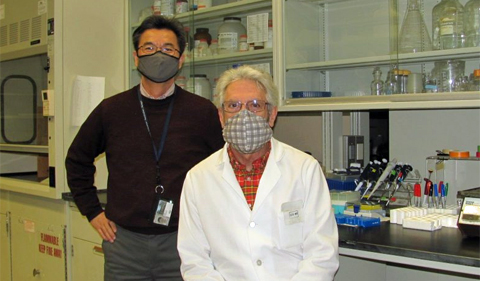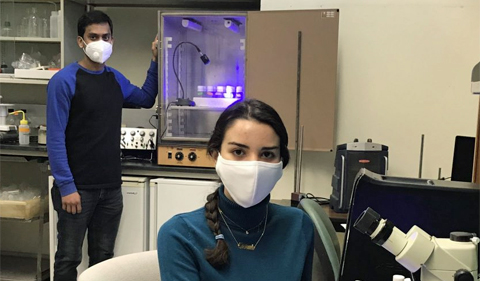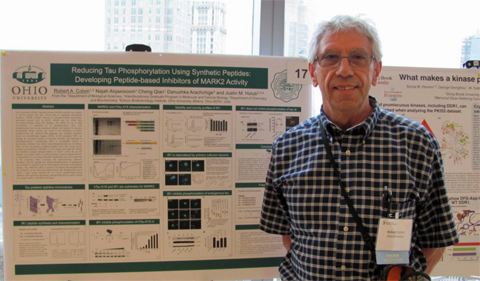
Dr. Daewoo Lee (standing) and Dr. Robert Colvin (seated) in the their lab, where Alzheimer’s disease research is conducted.
Long-standing research collaboration between Drs. Daewoo Lee and Robert Colvin has resulted in National Institutes of Health funding to study Alzheimer’s disease.
Lee and Colvin were always exchanging ideas as they crossed paths in the hallways of the Life Sciences Building. Now they are collaborating in their labs in search of how the tau protein spreads in the brain of Alzheimer’s patients.
Lee and Colvin and their research team recently received a three-year, $453,000 grant from the National Institutes of Health to continue their collaborative research project that seeks to identify and better understand the cellular mechanisms that underlie the pathogenesis of human neurodegenerative diseases, in particular, Alzheimer’s disease and Parkinson’s disease.
Lee, a professor of Biological Sciences, joined the faculty in 2002. He teaches currently physiology, molecular and cellular neuroscience, and biochemistry. Colvin is professor and chair of the Biological Sciences Department and a member of the Molecular & Cellular Biology program and joined Ohio University in 1990. Colvin currently teaches pharmacology and molecular and cellular neuroscience.
Although the research models used by Lee and Colvin are quite different — Lee using the fly Drosophila and Colvin using rats — they often probe similar questions about the cellular mechanisms that underlie the pathogenesis of human neurodegenerative diseases.
From Hallway Conversations to Collaborative Project
Lee and Colvin work in close proximity in the Life Sciences Building, so there always is a healthy exchange of ideas as they cross paths in the hallways. More than a decade ago, they decided to combine the strengths of each of their respective approaches to scientific inquiry and began submitting collaborative research projects for funding from national agencies such as the National Institutes of Health.
Scientists have worked for decades to understand the causative factors leading to Alzheimer’s disease. Much has been learned, but scientists are still unable to pinpoint causation, which has resulted in delays in developing effective treatments. Colvin began studying Alzheimer’s disease more than 30 years ago. At that time, he investigated the role that calcium transport proteins might have in disease progression.
More recently, he became interested in tau protein. Tau protein is an intracellular protein that is a pathological hallmark of Alzheimer’s disease. During the progression of Alzheimer’s disease, tau protein forms aggregates inside neurons eventually leading to the formation of structures called neurofibrillary tangles that destroy living neurons. It is thought that as the disease worsens, tau pathology and the formation of neurofibrillary tangles spreads throughout the brain.
But how does tau pathology spread form one area of the brain to another? As Lee and Colvin pondered this problem, they saw an opportunity to utilize strengths of their individual labs in a collaborative project. Now funded by the National Institutes of Health, they are studying mechanisms that allow the transfer of tau protein from one neuron to its neighbors. This process may be fundamental to disease progression and potentially will uncover new targets for effective treatments to slow or even stop the progression of the disease.
The project utilizes the genetic toolbox available for Drosophila, that makes available experimental models expressing human proteins. Also, Lee and Colvin are using optogenetics, which allows neuronal activity to be controlled by flashes of light of a certain wavelength. They are using optogenetics to study the release of human tau protein from Drosophila neurons in hopes of better understanding how these processes contribute to the progression of Alzheimer’s disease.
Lee also has had a long-standing interest in Parkinson’s disease, and he is now applying many of these newly developed experimental techniques to gain a better understanding of Parkinson’s disease.

Graduate students Sarah Baitamouni (seated) and Reaz Uddin (standing) demonstrating setups in lab used for light activated experiments.
The research team includes several graduate and undergraduate students enrolled at Ohio University. Ph.D. graduate student Ghadir Sindi is a project leader for the tau studies. Many of these experiments will be included in her Ph.D. dissertation. She has been working on this project for several years and will finish soon. After she graduates, Ghadir has plans to return to Saudi Arabia to be a university professor
Contributing author: Hannah Cordes



















Comments